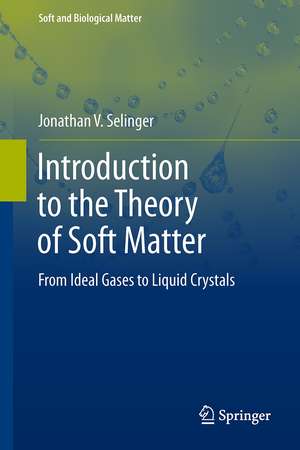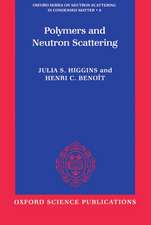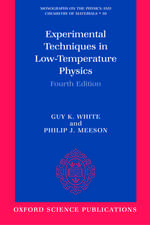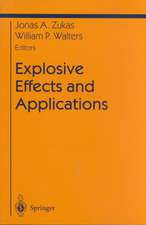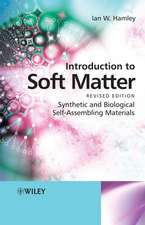Introduction to the Theory of Soft Matter: From Ideal Gases to Liquid Crystals: Soft and Biological Matter
Autor Jonathan V. Selingeren Limba Engleză Hardback – 29 aug 2015
| Toate formatele și edițiile | Preț | Express |
|---|---|---|
| Paperback (1) | 622.46 lei 6-8 săpt. | |
| Springer International Publishing – 23 aug 2016 | 622.46 lei 6-8 săpt. | |
| Hardback (1) | 833.35 lei 6-8 săpt. | |
| Springer International Publishing – 29 aug 2015 | 833.35 lei 6-8 săpt. |
Din seria Soft and Biological Matter
- 15%
 Preț: 652.17 lei
Preț: 652.17 lei - 18%
 Preț: 743.11 lei
Preț: 743.11 lei - 15%
 Preț: 642.18 lei
Preț: 642.18 lei -
 Preț: 372.11 lei
Preț: 372.11 lei -
 Preț: 389.70 lei
Preț: 389.70 lei - 15%
 Preț: 592.61 lei
Preț: 592.61 lei - 18%
 Preț: 1119.24 lei
Preț: 1119.24 lei - 15%
 Preț: 656.89 lei
Preț: 656.89 lei - 20%
 Preț: 572.40 lei
Preț: 572.40 lei - 18%
 Preț: 1115.14 lei
Preț: 1115.14 lei - 18%
 Preț: 1012.46 lei
Preț: 1012.46 lei -
 Preț: 389.49 lei
Preț: 389.49 lei - 18%
 Preț: 943.77 lei
Preț: 943.77 lei - 18%
 Preț: 735.84 lei
Preț: 735.84 lei - 18%
 Preț: 789.52 lei
Preț: 789.52 lei - 18%
 Preț: 1010.17 lei
Preț: 1010.17 lei - 18%
 Preț: 952.09 lei
Preț: 952.09 lei
Preț: 833.35 lei
Preț vechi: 980.42 lei
-15% Nou
Puncte Express: 1250
Preț estimativ în valută:
159.46€ • 166.49$ • 131.97£
159.46€ • 166.49$ • 131.97£
Carte tipărită la comandă
Livrare economică 04-18 aprilie
Preluare comenzi: 021 569.72.76
Specificații
ISBN-13: 9783319210537
ISBN-10: 331921053X
Pagini: 188
Ilustrații: X, 185 p.
Dimensiuni: 155 x 235 x 17 mm
Greutate: 4.2 kg
Ediția:1st ed. 2016
Editura: Springer International Publishing
Colecția Springer
Seria Soft and Biological Matter
Locul publicării:Cham, Switzerland
ISBN-10: 331921053X
Pagini: 188
Ilustrații: X, 185 p.
Dimensiuni: 155 x 235 x 17 mm
Greutate: 4.2 kg
Ediția:1st ed. 2016
Editura: Springer International Publishing
Colecția Springer
Seria Soft and Biological Matter
Locul publicării:Cham, Switzerland
Public țintă
Upper undergraduateCuprins
Toy Model.- Ising Model for Ferromagnetism.- Gases and Liquids.- Landau Theory.- First Mathematical Interlude: Variational Calculus.- Field Theory for Nonuniform Systems.- Dynamics of Phase Transitions.- Solids: Crystals and Glasses.- second Mathematical Interlude: Tensors.- Liquid Crystals.
Recenzii
“Selinger’s book is clearly an excellent, well-written introduction to the phenomenology and concepts of soft matter physics. I enjoyed reading it and can but recommend it to students of theoretical physics with an interest in pursuing this research direction, or to those that would need a good background to the contemporary research literature … . recommended this book to my graduate students with the path to theoretical soft matter physics in mind, as the first that they should read.” (Rudolf Podgornik, Liquid Crystals Today, Vol. 26 (2), April, 2017)
“Introduction to the Theory of Soft Matter: From Ideal Gases to Liquid Crystals, presents students with many of the key methods and principles of condensed-matter theory that have been valuable for understanding and engineering soft matter, with a particular focus on the theory of liquid crystals. … It will be a valuable asset for students and junior researchers who are in a growing interdisciplinary field and are looking for an approachable yet rigorous introduction to many of its cornerstone principles.” (Greg Grason, Physics Today, scitation.aip.com, November, 2016)
“Introduction to the Theory of Soft Matter: From Ideal Gases to Liquid Crystals, presents students with many of the key methods and principles of condensed-matter theory that have been valuable for understanding and engineering soft matter, with a particular focus on the theory of liquid crystals. … It will be a valuable asset for students and junior researchers who are in a growing interdisciplinary field and are looking for an approachable yet rigorous introduction to many of its cornerstone principles.” (Greg Grason, Physics Today, scitation.aip.com, November, 2016)
Notă biografică
Jonathan Selinger is Professor of Chemical Physics and Ohio Eminent Scholar at Kent State's Liquid Crystal Institute. His research focuses on the theory of liquid crystals, nanoparticle suspensions, and related topics in soft materials and seeks to make connections between fundamental statistical mechanics and technological applications.
Selinger studied physics at Harvard University, receiving his A.B. in 1983 and Ph.D. in 1989. He then did postdoctoral research in Los Angeles, with positions at the UCLA Department of Physics and Caltech Department of Chemical Engineering. In 1992 he moved to the Naval Research Laboratory in Washington, DC, where he worked as a Research Physicist in the Center for Bio/Molecular Science and Engineering. In 2005 he came to his current position at Kent State. In addition to these research and teaching positions, he has also served as Associate Editor of Physical Review E, responsible for the liquid-crystal section of the journal.
Selinger studied physics at Harvard University, receiving his A.B. in 1983 and Ph.D. in 1989. He then did postdoctoral research in Los Angeles, with positions at the UCLA Department of Physics and Caltech Department of Chemical Engineering. In 1992 he moved to the Naval Research Laboratory in Washington, DC, where he worked as a Research Physicist in the Center for Bio/Molecular Science and Engineering. In 2005 he came to his current position at Kent State. In addition to these research and teaching positions, he has also served as Associate Editor of Physical Review E, responsible for the liquid-crystal section of the journal.
Textul de pe ultima copertă
This book presents the theory of soft matter to students at the advanced undergraduate or beginning graduate level. It provides a basic introduction to theoretical physics as applied to soft matter, explaining the concepts of symmetry, broken symmetry, and order parameters; phases and phase transitions; mean-field theory; and the mathematics of variational calculus and tensors. It is written in an informal, conversational style, which is accessible to students from a diverse range of backgrounds. The book begins with a simple “toy model” to demonstrate the physical significance of free energy. It then introduces two standard theories of phase transitions—the Ising model for ferromagnetism and van der Waals theory of gases and liquids—and uses them to illustrate principles of statistical mechanics. From those examples, it moves on to discuss order, disorder, and broken symmetry in many states of matter, and to explain the theoretical methods that are used to model the phenomena. It concludes with a chapter on liquid crystals, which brings together all of these physical and mathematical concepts. The book is accompanied by a set of “interactive figures,” which allow online readers to change parameters and see what happens to a graph, some allow users to rotate a plot or other graphics in 3D, and some do both. These interactive figures help students to develop their intuition for the physical meaning of equations. This book will prepare advanced undergraduate or early graduate students to go into more advanced theoretical studies. It will also equip students going into experimental soft matter science to be fully conversant with the theoretical aspects and have effective collaborations with theorists.
Caracteristici
Offers a unified description of order, disorder and phase transitions in soft materials Provides tutorials on necessary mathematics (variational calculus, tensors) Enriched with many worked examples and interactive figures Written in an informal and approachable style Suitable for advanced undergrads and graduate students in physics and chemistry, as well as chemical engineering, materials science, mechanical engineering or bioengineering departments Includes supplementary material: sn.pub/extras
